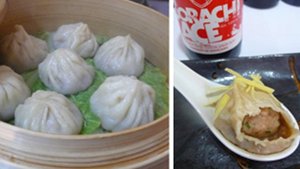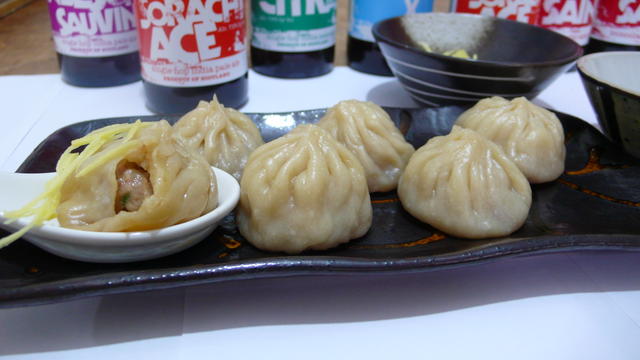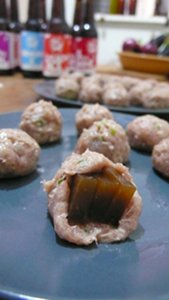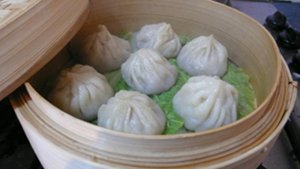Note: Due to ‘the harddrive fire of 2011’ I’ve had to restore this page from the Beer Reviews winning recipe announcement.
It all started with beer..
Beer Reviews Andy provoked the beer-loving masses back early this year to consider this: if there are so many more choices in matching food with beer over wine, then why aren’t there more recipes beyond the regular pub-grub? With a such a tempting carrot dangling (a mixed case from My Brewery Tap) as the grand prize even I was excited about the possibilities.
But I wanted to be different, and this meant that I had to go beyond even my very limited culinary repertoire – as I knew Yvan had more than one recipe up his sleeve to submit (where one was featured at the time of (re)writing). Knowing that such tough competition was even under the same roof, I wanted something not impossible but something overlooked.
Some background: as Australians that lived in Sydney, tasty, fairly authentic Chinese cuisine was easily accessed (and consumed). Fast forward some time I had come across instructions for the yum cha (dim sum for you poms) classic: xiao long bao via the precision method for eating them. The recipe sounded difficult, and very time consuming, and intimidating through the procedure (not complex, just tedious). The recipe sat in the recesses of my mind to perhaps try later..
.. then as I thought about recipes for the competition, I found it was the right moment to attempt these soup-filled dumplings – fear aside. As they were soup filled I thought that was a great opportunity to really incorporate beer into this recipe. Thus, I give you beer xiao long bao!
The recipe proper
Introduction/prep
There are 3 main components with this dumpling: a strong stock that is solid at cooler temperatures (gelatin is traditional), a meaty dumpling filling and a robust wrapper. The soup and meat filling are combined before being wrapped; when they are steamed the heat melts the stocky soup and apart from imparting it’s flavour to the filling it helps cook the meat.
In this recipe I used a Sorachi Ace single-hop beer from Brewdog; I found that it had an interesting flavour that would complement the filling without being too bitter when heated.
(Solid) Beer Soup
This component can be prepared well in advance. We have stock in the freezer on hand as we tend to make large batches of the stuff now and then. Adding a pig’s trotter to a large stock will give it enough gelatin to set the stock for real home-made stock cubes (less messy when defrosted). It is probably when we started doing this more often I discovered the xiao long bao recipe as one of the uses the stock can go to. I added agar agar to be certain that the stock can still stay solid with the addition of the beer at room temperature.
Of course, if you don’t make your own stock you can use the store-bought stuff, though I’d imagine it doesn’t have a good intense flavour that you can get when home-made.
- 150ml Strong (5x reduced) chicken/trotter stock and 150ml water OR
- 300ml of shop chicken stock (the refrigerated section)
- 1 slice fresh ginger
- 200ml beer (Sorachi Ace from BrewDog)
- 1/2Tb agar agar OR
- 1Tb agar agar if not using strong stock/water mix
Method:
- Heat the water and stock until warm, then add the ginger. Simmer for 2 minutes.
- Add the beer, and then all the agar agar. Heat until simmering until the agar agar melts.
- To speed things up, you can whisk the soup to aid combining the agar agar
- Place in a shallowish baking dish lined with cling wrap. Allow to set into a jelly then set aside (fridge)
This makes only half the amount of stock as the original recipe, so the other components may have a surplus than required for the soup.
Filling
I tweaked the traditional porky filling so it doesn’t overwhelm the beer flavour in the stocky soup.
- 366g pork mince
- 184g prawn, minced
- 2 cloves of garlic, minced
- 1Tb fresh ginger, minced (I have a grater for this)
- 2Tb soy
- 2tsp caster sugar
- 13g minced spring (green/salad) onion – just the green parts, avoid white bits near the root)
You can chose the sensible or complicated methods:
- Fast method: Combine the diced solid stock and filling ingredients, mincing the solid stock well into the filling for even coverage. For the quantity of soup you will need only half of the total mince, so either half the quantity or double the soup component. Set aside in the fridge
- ‘Cube’ method: Cut the solid stock into 7-10mm cubes. Combine all but the green onion. Use a food processor to finely mince the meat into a more of a pasty consistency. Mix in the green onions into the meat mix and set aside in the fridge (the cube part is part of the construction phase)
The traditional method was designed for speed and better soup distribution, but method 2 makes prettier photographs.
Dumpling wrappers
It is highly recommended that you do this from scratch, but there are suggestions to replace this with premade wrappers (rolls eyes). If you’re going through the trouble, might as well go whole hog! The way these are made ensures that the wrappers can be rather thin but robust enough to handle a hot soup without breaking.
As per instructions on Steamy Kitchen; I converted the American units to be roughly:
- 400g plain flour
- 177ml boiling hot water
- 60ml cold water
- Sesame oil for rising
Method:
- From the 400g of flour, reserve about 10% for dusting/adding-to-dough-when-too-wet
- Pour in about a third of the hot water then stir with cooking chopsticks. Rinse (not literally) and repeat
- When all the hot water has been used and the dough has taken in the hot water add the cold water. Mix in the water with the chopsticks until it gets too difficult
- On a floured surface, knead the dough for about 8-10 minutes. The dough should be springy – if you make a slight poke into it it should spring up in a few seconds
- Store in an oiled bowl and cover for 30 minutes. I ran out of cling wrap, so I used a kitchen towel
To see just how strong this dough gets, see Hiromasa Yamanaka at Jin Din Rou stretching the dough.
Condiment: shredded ginger
- Large fresh ginger
Method:
- Peel the ginger with a vegetable peeler
- Plane off thin sheets with the peeler (until you can’t stands it no more)
- Slice into thin strips with a knife
Condiment: black vinegar dipping sauce
I don’t have Chinese black vinegar at hand so I made a mix that incorporated more beer! Just mix the following together:
- 2Tb beer
- 1Tb balsamic vinegar
- 1tsp rice vinegar
- 1/2 sugar (to taste; I didn’t add any but if the beer is too bitter then add as needed)
Construction of wrappers and dumplings
If you are not equiped with another pair of hands, I suggest to make small batches of wrappers at a time and then fill them. Otherwise, do as the pros and designate tasks to speed up the process.
And here is the ‘cube’ complication. If you were like me, the ‘cube’ method involves covering each (or a lump of squares) of the stock cubes you cut earlier with the mince filling. As handling the mince directly is sticky business, lightly oil you hands with sesame oil when doing this. Otherwise, the fast method just involves scooping out appropriately sized balls.
Refrigerate the mince (normal) or balls (cube) to be ready for the next stage.
The filling ‘balls’ final size for me was about 3cm (or slightly smaller) in diameter if you use the cube method.
Wrappers
You’ll be stuck near the floured surface a while; ensure you have flour handy for dusting. I copied a method I saw on the interwebs, though I wish I was that fast..
- Roll out all of the dough into a thick sausage, about 5cm in diameter
- Segment the dough into 4 equalish parts. This is so you can handle smaller parts at a time
- Return 3 segments to the bowl that it was resting in. Roll the last segment into a thinner 1.5-2cm diameter sausage. I was uncomfortable handing the dough quickly enough so I halved that again and dealt with an eighth at a time
- Make rough 1.5×1.5 squares from the dough segment. Place these on the floured surface
- For each wrapper, roll the rough segments into balls, then flatten on the floured surface. Use a ‘hand’ rolling pin or a pair of cooking chopsticks to roll the dough into a circle about 7.5cm in diameter
If you are not alone, you can speed things up by passing the completed wrappers to..
Dumpling making
- Place the filling in the center (roughly a 3cm ball) and pleat the dumpling as shown in Steamy Kitchen (or YouTube – the pros are fast)
- Place completed dumplings on a floured surface until batches are ready for the final stage..
Steaming
At this stage, if you did this all on your own then congratulations! You’re just as crazy as I! Actually, at this stage, the smells from the steamer may make you crazy hungry..
- Place water in a saucepan that fits a bamboo steamer. Set to the highest heat
- While waiting for the water to boil place washed and size-trimmed Chinese cabbage OR other cabbage OR baking paper in the steamer levels
- If using cabbage lining, place the steamer levels in place and let them steam for 2 minutes. Forgo the 2 minute steam if you are using paper
- When the steamer is ready, place enough dumplings in each level (don’t overcrowd and don’t let them touch!) and steam for about 12 minutes (top tier). Steam the bottom level for another 5-8 (or shorter if rotating)
Serving and Eating
Serve hot with julienned strips of ginger and the dipping sauce. If you don’t want to squirt yourself or others with the hot soup, read Rasa Malaysia’s tips. Basically the procedure is:
- Carefully pick up a dumpling with your chopsticks and dip into the sauce
- Top with ginger if using
- This is the crucial step: nibble a little of the dumpling skin. If you sense soup emerging, then slurp sensible amounts at a time
- If the dumpling is cool enough or out of scalding soup then you can eat it safely!

Beer xiao long bao for dinner, accompanied by a perfectly matched beer (Sorachi Ace by Brewdog) and perfect company
Final Notes
I don’t recommend the cube method as I found it to use far more mince filling than what the original recipe intended. I found this batch to be on the meaty side (but still tasty). The beer flavour was still present, which alongside pork and ginger was a great combination. Also, there was a hint of bitterness but the prawns and ginger seemed to have sweetened things to balance it out. It was great to slurp out the soup and taste the beer, chowing down on the dumpling then following up with a refreshing swig of the same beer – a contrast of textures and temperatures.
Pretty good for my first (but not last) batch of xiao long bao, and first attempt to really cook with beer! (Perhaps a simpler recipe next time – I’ve always wanted to try a tin-can-BBQ chicken – it’s a great conversation starter!)
Leftovers
What do you do when you’ve made too many dumplings? You can freeze them! Just be careful – I placed them carefully on a tray in the freezer so each dumpling didn’t freeze together, then I placed them in a cling-wrap lined container that was floured. You can steam these from frozen – they just take longer than if they were done fresh.
Since I used the amounts for 4 (American) cups of soup I had leftover wrapper dough and mince filling. I made gyoza with the leftover wrappers and mince: just add some shredded cabbage to the mince and proceed as normal!
Apart from dumplings, the mince looks awfully tempting to be a spring roll filling. Or “Lumpiang Hubad” (‘naked’ lumpia/spring rolls: referring to the lack of wrapper) perhaps? I have seen similar mince balls that are cooked in a soup and served with rice noodles.. Too little leftovers to try all of the above!





